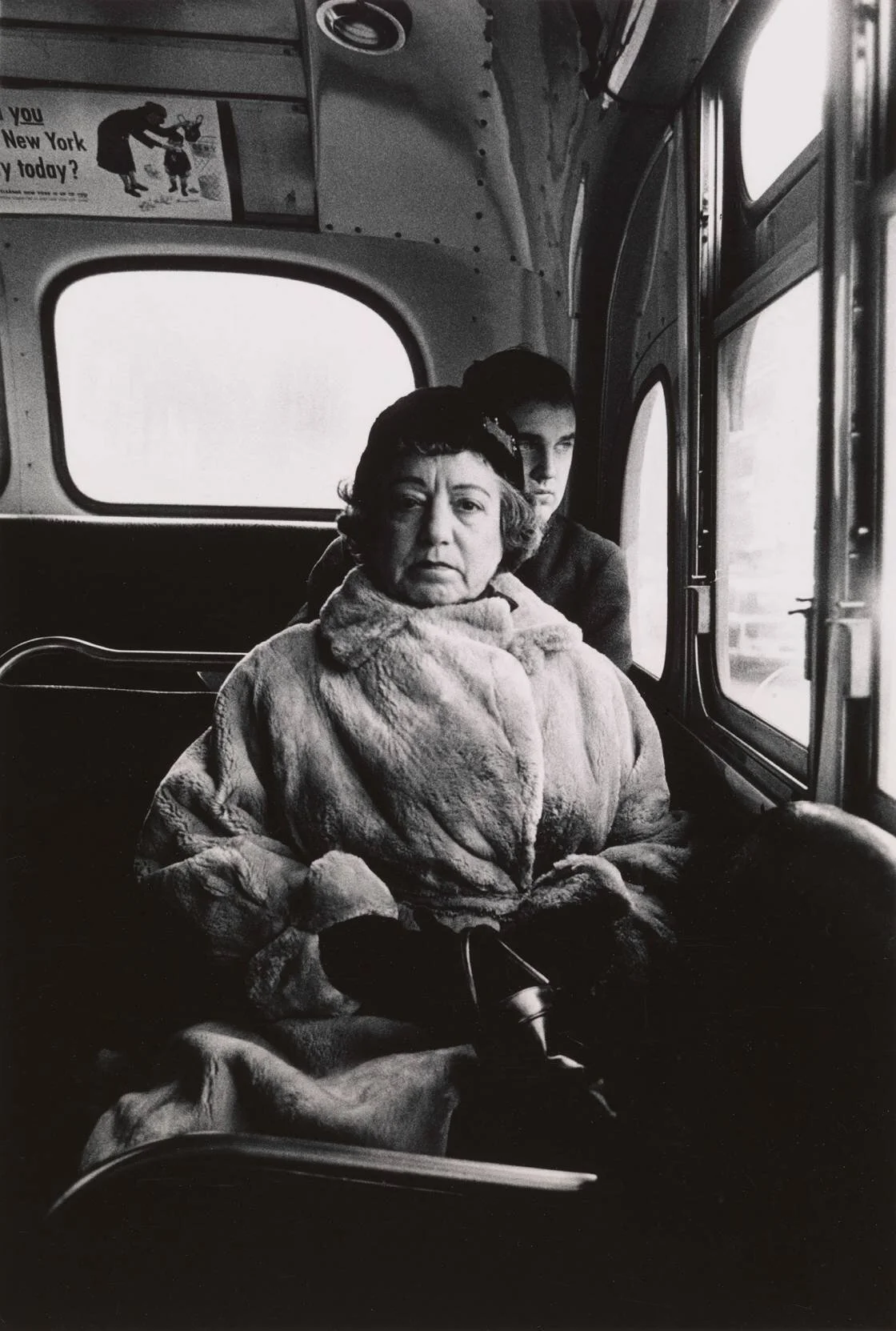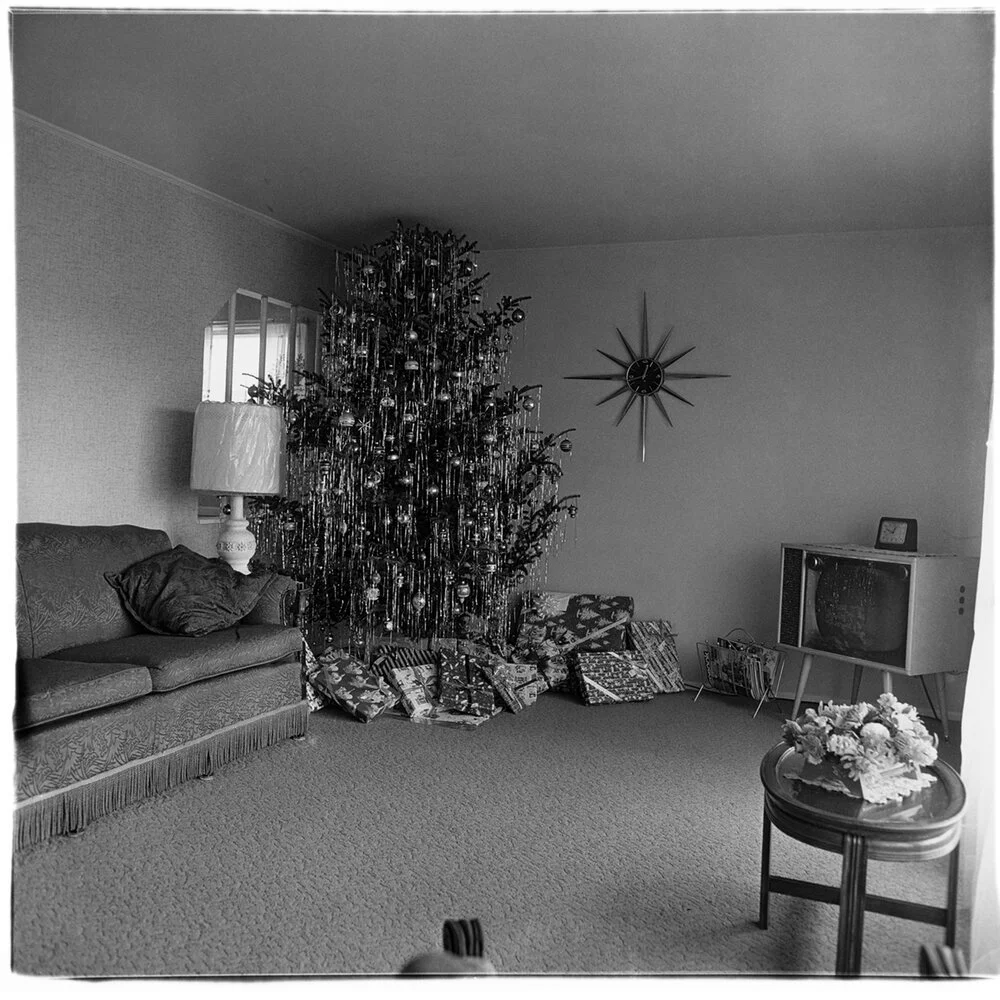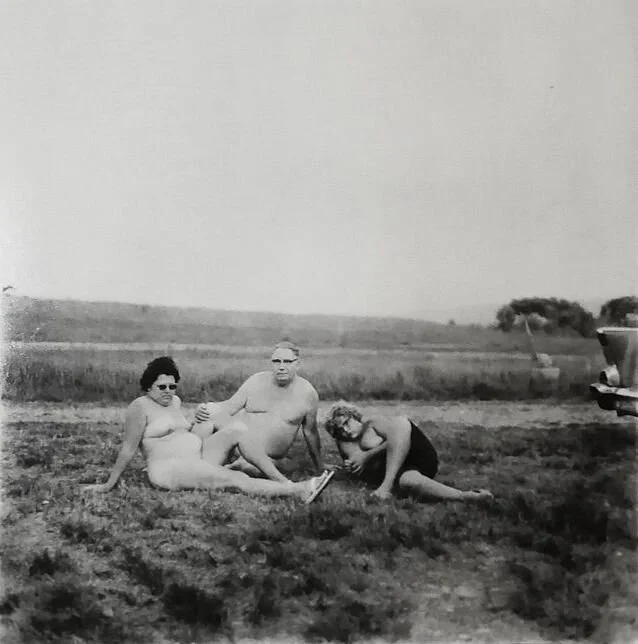DIANE ARBUS
Diane Arbus, really Diane Nemerov, was born in a wealthy Jewish family in 1923 and grew up in New York City, having a lavished childhood living in beautiful homes and being looked after by maids.
The creative flow runs through the family being his brother and sister both in the arts as a writer and a sculptor and designer.
Her father pushed her into the world of painting which she took at college never letting the family know her dislike for it.
Diane’s mother always suffered from mental health issues, including depression, something that deprived her of being as close to her and a true guide for her daughter.
It is through the family business that Diane met her husband, Allan Arbus, a photographer employed by her father to organize the advertising department of his fur business.
At that stage, at the age of 14, Diane felt that marriage was the right path for her, and, even with the disapproval of her father, she quit painting and college and married Allan to become a wife, in 1954 also a mother of her first daughter.
After marrying Allan she started working with him in her family business helping with the styling and art directing of shootings for her father's advertising newspaper.
The couple soon became known in the photography industry and started to publish in major fashion editorials such as Vogue, Glamour, and Harper's Bazaar.
Diane Arbus, da nubile Diane Nemerov, nasce in una ricca famiglia ebraica nel 1923 e cresce a New York City, ha un’infanzia elitaria vivendo in case bellissime e sotto la cura di governanti.
É chiaro che nella famiglia scorra la creatività essendo entrambi il fratello e la sorella ben inseriti nel mondo dell’arte come scrittore e come scultrice e designer.
Suo padre la spinge verso il mondo della pittura che accetta di percorrere scegliendolo come indirizzo universitario senza mai far sapere alla famiglia quanto in realtà non le piacesse.
La madre di Diane soffriva di problemi di salute mentale, inclusa una forte depressione, cosa che le ha sempre impedito di starle vicina ed essere una guida per la figlia.
É attraverso il business di famiglia che Diane incontra suo marito, Allan Arbus, un fotografo ingaggiato da suo padre per organizzare il reparto di advertising del suo store di pellicce.
In questa fase, all’età di 14 anni, Diane sente che il matrimonio sia la giusta scelta da percorrere e così, anche contro il volere del padre, abbandona l’università e la pittura e sposa Allan per essere una moglie prima e nel 1954 anche una madre della sua prima figlia.
Dopo il matrimonio inizia a lavorare con Allan nello store di famiglia aiutandolo con lo styling e la direzione artistica dei servizi fotografici per il giornale pubblicitario del padre.
La coppa presto diventa ben conosciuta nel settore della fotografia ed inizia a pubblicare editoriali in importanti testate del settore come Vogue, Glamour e Harper’s Bazaar.
Allan gave Diane her first camera.
After working together for quite a while Diane realized she wanted more from photography than simply being an assistant and a stylist and after the birth of her second daughter in 1954 she started taking photography classes with Lisette Model.
This is when Diane started looking at photography as an inspiring form of art worth work and dedication and started working on her own.
She started numbering her negatives as she would for the rest of her life, as much as collecting notes, ideas, parts of conversation, stories she had heard, and anything that could trigger her interest and imagination, and noted it all in her diaries.
Allan regalò a Diane la sua prima macchina fotografica.
Dopo aver lavorato insieme a lungo Diane capisce che desidera di più dal mondo della fotografia che rimanere una semplice collaboratrice stylist e, dopo la nascita della seconda figlia, inizia a seguire un corso di Lisette Model.
In questo momento Diane inizia a guardare alla fotografia come una stimolante forma d’arte che vale dedizione e duro lavoro e cosi inizia a scattare da sola.
Inizia a numerare i suoi negativi, come continuerà a fare per il resto della sua vita, così come raccogliere note, idee, parti di conversazioni ascoltate, qualsiasi cosa che sia in grado di cogliere la sua attenzione e che meticolosamente annota nei suoi diari.
By the time her marriage with Allan was over in 1959 she had found her new purpose in life being photography the centre of it and managed to make a humble living through commercial work. At this stage she managed to work for Esquire where, thanks to the magazine’s new approach to photojournalism and story telling, she started to forge what it will become her signature style of image making.
In 1963 she received a grant for the Guggenheim Foundation (and again in 65 and 66) and in 1967 she has her first exhibition at the MOMA.
After 1968 Diane started to get ill with depression and Hepatitis B.
Allan’s move to California to become an actor took its tool on her considering it a final separation from her husband to which she remained very close all her life even after their divorce.
She kept deteriorating and developed negative reactions towards the meds that would have helped her be more mentally balanced.
In 1971 she told her friends that photography wasn’t helping her anymore and that it no longer had that power of fulfillment over her and the 26th July of the same year Diane was found dead by overdose and cuts of her wrists.
Quando il suo matrimonio con Allan finì nel 1959 aveva gia trovato un nuovo stimolo con la fotografia al centro della sua vita e riuscì a vivere e mantenere le figlie con lavori commerciali. Inizia a lavorare per il famoso giornale Esquire dove, grazie al nuovo approccio della testata al fotogiornalismo e al modo di “raccontare” attraverso le immagini, Diane inizia a forgiare quello che diventerà il suo stile iconico nella produzione visiva.
Nel 1963 riceve un premio economico per la Guggenheim foundation (e ancora nel ‘65 e ‘66) e nel 1967 espone la sua prima mostra al MOMA.
Dal 1968 Diane inizia ad ammalarsi a causa di una depressione e dell’Epatite B contratta in precedenza.
Il trasferimento di Allan verso la California per diventare un attore nel ‘69 ha un forte impatto su Diane, considerandolo una separazione finale dall’ex marito, al quale era rimasta sempre molto legata anche dopo il divorzio.
Il suo stato di salute continua a peggiorare e sviluppa reazioni sbagliate ai farmaci che la aiuterebbero a mantenere un equilibrio mentale.
Nel 1971 Diane dice ad alcuni amici che la fotografia non era più in grado di aiutarla e che da questa non riusciva più a trarre un senso di realizzazione personale e il 26 Luglio dello stesso anno viene trovata morta per overdose e taglio dei polsi.
Diane’s style put documentary photography to use in a completely new and different way by capturing real-life subjects in their natural environment.
Feeling herself always an outcast she was constantly attracted to those excluded by the general view and not only did she have the power to see aspects in them of a truth that was ignored by everyday society but also she proved brave in looking for a confront with extremely different and complicated people and their lives.
She began by visiting Freaks show and every setting where physicality and, above all, its oddity and mutations, were put on display for others to watch and enjoy and in doing so she started to try to understand better the line between “us and the others”.
“What I’m trying to describe is that is impossible to get out of your skin into somebody else’s and that’s what all this is a little bit about. Thad somebody else's tragedy is not the same as your own”.
Lo stile di Diane rende completamente nuovo l’utilizzo del fotogiornalismo e della fotografia documentaristica proprio nel modo in cui sceglie di catturare persone vere nel loro ambiente naturale e quotidiano.
Essendosi sempre sentita un’emarginata dal proprio ambiente di origine è costantemente attratta da tutti quelli che rimangono esclusi dalla struttura sociale e non solo dimostrò il potere di vedere nei sui soggetti aspetti di una realtà che veniva totalmente ignorata dalla società del tempo ma dimostrò anche un tremendo coraggio nel cercare di confrontarsi costantemente con individui molto diversi tra loro e con vite difficili e complicate.
Iniziò con il visitare Freaks Shows e tutte quelle piattaforme dove il corpo, e soprattutto le sue stranezze e mutazioni, venivano messe in mostra come spettacolo e comincia così a cerare di identificare ed interpretare la linea che divide “noi dagli altri”.
“Quello che cerco di descrivere è il fatto che sia impossibile uscire dalla propria pelle ed entrare in quella degli altri e questo è un po’ la base di tutto quello (che faccio). Che la tragedia di qualcun altro non è mai uguale a quella che vivi tu”.
For many the selection of her most vulnerable subjects was a mere way of exploitation, for others, she simply channeled into her work her feeling of being an outsider and actively decided to give a light to all the ones nobody would ever dare look other than because of their “strangeness”.
Diane once said, “Freaks don’t have to go through life dreading what may happen, it’s already happened. They’ve passed their test. They’re aristocrats”.
Many scholars, critics, and important and prominent people in the world of literature and sociology (Susan Sontag: ” Her work shows people who are pathetic, pitiable, as well as repulsive, but it does not arouse any compassionate feelings”) kept attacking the fact that many of the subjects she had chosen in her works weren’t either mentally capable of making an active decision of participating nor posing in ways that wouldn’t necessarily
reflect their differences.
Her work through the years spanned from “freak shows” to a middle-class nudist camp, from youth gangs to suburban lower-class people even up to the rich and the elite of New York City.
Despite the many critics she had received she always thought that her work “sought to capture the space between who someone is and who they think they are” and she is and will be known to remain one of the most unique Post Modern American photographers whose work manage to permeate and drastically influence and even change fashion, street and political photography forever.
Per molti la scelta dei sui soggetti più vulnerabili era semplicemente una forma di sfruttamento,per altri Diane semplicemente canalizzava nel suo lavoro i suoi sentimenti di marginalità decidendo attivamente di dare luce a tutti quelli che nessuno avrebbe mai guardato se non per la loro “stranezza”.
Una volta disse “i Freaks non devono passare la vita a chiedersi cosa succederà. (per loro) É gia successo. Hanno passato il test. Sono degli aristocratici”. Molti studiosi, critici, importanti membri del mondo letterario e sociologico (Susan Sontag: ”il suo lavoro mostra persone patetiche, pietose e ripugnanti, ma non suscita alcun sentimento di compassione”) attaccano il fatto che molti dei soggetti dei suoi lavori non fossero nelle condizioni mentali ed intellettuali di poter acconsentire a partecipare alle sue fotografie ne tantomeno di poter posare in modi che non necessariamente riflettessero le loro difference.
I lavori di Diane negli anni hanno variato da “freak Shows” a campi nudisti di ceti borghesi, da gangs di giovani a persone di basso ceto ai margini della città fino anche all’ elite e alla classa ricca e borghese di New York City.
Nonostante le critiche ricevute Diane ha sempre pensato che le sue opere “cercassero di catturare lo spazio tra quello che qualcuno è e quello che pensa di essere”.Arbus rimarrà uno dei fotografi più unici dell’America post moderna il cui lavoro è riuscito a permeare ed influenzare il mondo della fotografia di moda, di reportage, e del fotogiornalismo, fino ad oggi.




















